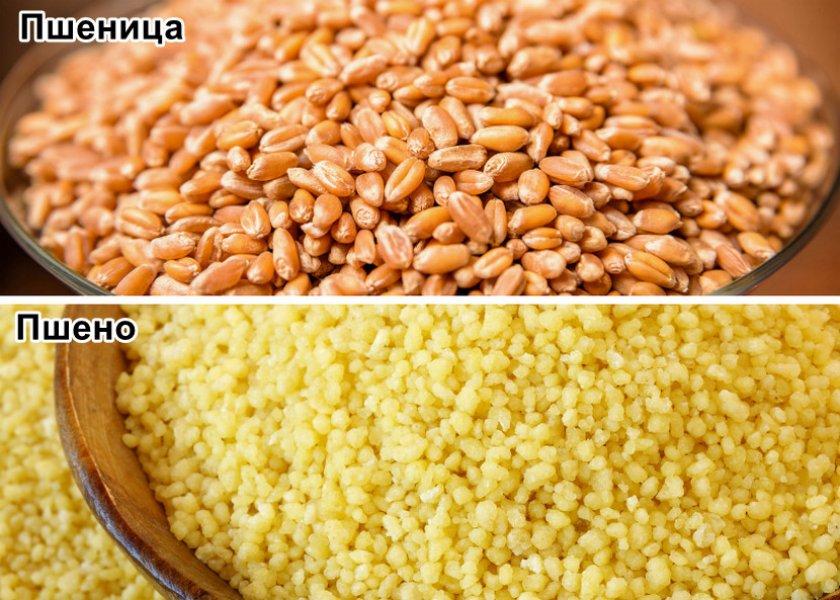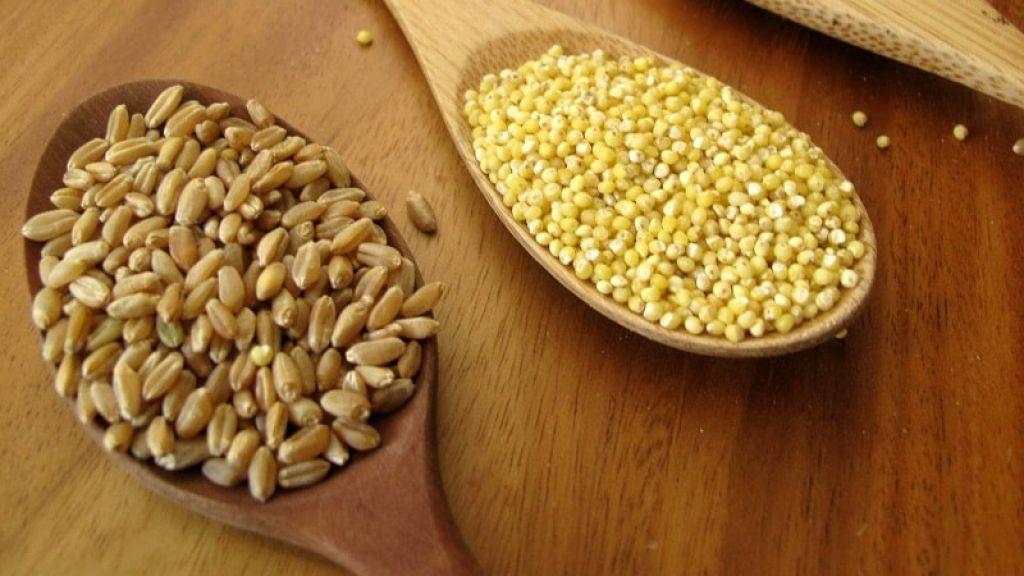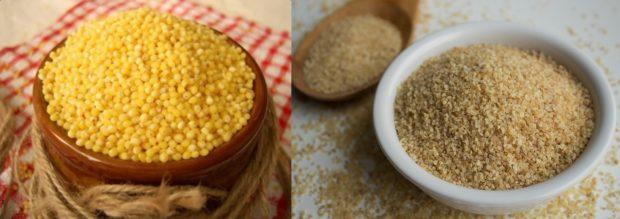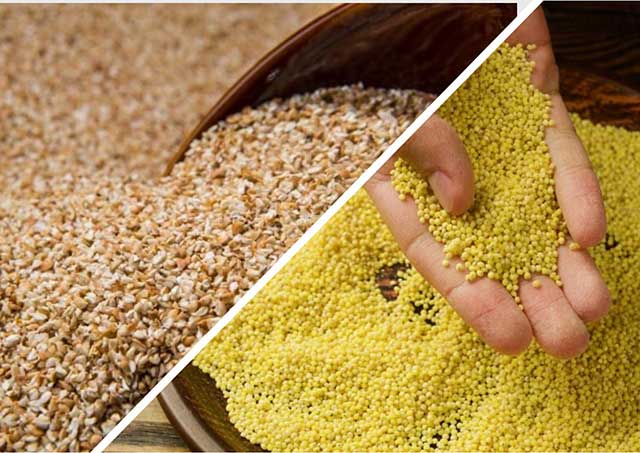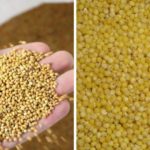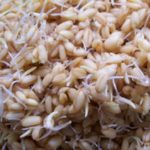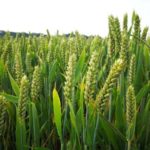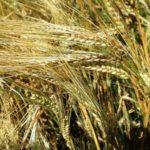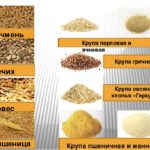Millet and wheat are two words whose origin is associated with the ancient Slavic verb “pykhati”, which translates as “pound”. In ancient times, people processed grains in mortars and removed the husks using crushers. According to another version, both concepts come from the Polish word "pseno". Despite the same root, these are completely different cereals. So what is the difference between millet and wheat, how to distinguish them by appearance and taste, and which is healthier?
Word definitions
Phonetically similar names are used to refer to different types of cereals. They differ in appearance and composition. Therefore, these cereals have found different uses in cooking.
Wheat is a genus of herbaceous cereal plants. It is considered one of the most sought after crops in the world. This genus includes 20 species, each of which includes up to a dozen varieties.
Flour is made from wheat, which is used for confectionery products. It is also used to produce bread and pasta. In addition, the product is actively used for the production of alcohol. The following types of cereals are made from wheat:
- bulgur - is a whole, peeled and polished wheat grain that is processed using hot steam;
- semolina is crushed purified grains, the particle diameter of which is 0.25-0.75 millimeters;
- wheat - consists of crushed grains;
- Couscous is essentially granulated semolina.
Millet is a cereal grain that is obtained by processing the seeds of cultivated varieties of millet. Its grains are round or oval in shape and yellow in color. In their raw form, their diameter is 1-2 millimeters.
Depending on the processing methods, there are the following types of millet:
- polished - is a high-quality cereal, the kernels of which are polished to get rid of the aleurone layer;
- crushed is crushed millet, which in appearance resembles wholemeal flour and is perfect for baking bread and viscous porridges;
- dranets - is a low-quality cereal, which is cleared only of the coarse shell.
Key differences
The types of cereals under consideration differ in visual properties, composition, characteristics, and effect on the body.
Appearance
Millet and wheat have noticeable visual differences. Millet is characterized by round grains that have a rich yellow tint. When finished, the product is light and airy.
Visual characteristics largely depend on the type of cereal. Polished millet is considered to be of the highest quality. It is rougher than shingles and has a light color. Millet-dranets is distinguished by smooth grains that have a rich yellow tint. Crushed cereals are obtained by processing grains. This product consists of crushed fractions. The color in this case can be different - light or more saturated.
Wheat grains are distinguished by a golden hue and are covered with a hard film - bran. After grinding, they turn into white flour. The bran becomes grayish after processing.
Composition and abundance of vitamins
Cereals have significant differences in composition, which affects the properties of the products. Millet is a healthy product that contains many important components. Among them it is worth highlighting the following:
- B vitamins;
- amino acids;
- manganese;
- potassium;
- fluorine.
Wheat contains the following ingredients:
- vitamins of group B, C, A;
- carotene;
- sodium;
- iron;
- phosphorus;
- potassium;
- calcium.
Distinctive properties of each cereal
Millet and wheat have different effects on the body. The difference lies in the characteristics of the products. Depending on their composition, these cereals can be harmful or beneficial.
Millet contains many nutritional elements, which allow us to conclude that this product is not harmful to health. Moreover, its regular use has a beneficial effect on brain function. This is due to the high content of valuable amino acids.
The most valuable ingredient in wheat is bran. They include ballast components that help cleanse the body of toxins. In addition, bran has a good effect on the functioning of the digestive organs.
It is important to consider that the most beneficial substances are present in the thin shell of wheat that covers the grains. The kernels themselves, from which flour and bread are made, do more harm than good.
Contraindications
Wheat should not be consumed by people who suffer from diabetes. This is due to the high glycemic index of the product. Millet is contraindicated for inflammation of the digestive system. It is also not recommended to eat it if you have thyroid pathologies.
Where is millet and wheat used?
The products in question have found wide application in various areas of human life. They are actively used in cooking to prepare tasty and healthy dishes. In addition, the beneficial properties of these cereals make it possible to use them in medicine. They successfully cope with the symptoms of a wide variety of pathologies.
Medicine
Millet can be safely used for the treatment and prevention of various diseases:
- This cereal helps you lose excess weight. Today there are many millet diets for people who have metabolic disorders. A nutritionist will help you choose a specific option and make your diet more balanced. First, he will prescribe biochemical tests that will help assess the condition of the body.
- Millet supports kidney function. It improves the condition of cystitis and urolithiasis.People who live in regions with hard and poorly treated tap water should include millet in their diet.
- Magnesium and potassium, which are contained in millet, have a beneficial effect on the body of people suffering from arterial hypertension. Improving the functions of the excretory organs also has a good effect on the condition of blood vessels and helps reduce blood pressure.
Wheat germ extract is actively used in traditional medicine. This remedy has pronounced immunomodulatory properties. In addition, it promotes the healing of ulcerative lesions, wounds and burns. Wheat starch is often included in ointments, enemas and powders.
In folk medicine, wheat decoction is often used. This remedy helps strengthen the body after traumatic injuries and diseases. A decoction prepared from wheat bran can be used for constipation. It should be included in enemas. Wheat decoction with honey and medicinal herbs is useful for coughs.
Sprouted wheat has immunostimulating, rejuvenating and restorative properties. It can be used raw or used to prepare milk and health cocktails.
For wheat to have a medicinal effect, it is important to use fresh grains. It is recommended to buy them immediately after harvest. Bean labeling is of great importance. They must undergo quality control in accordance with GOST.
Cooking
Cereals are actively used in cooking. You can make a large number of tasty and healthy dishes from them. Millet is most often used to prepare porridges. First you need to rinse the cereal and soak it in water for 1-2 hours. After which it needs to be brought to a boil and cooked over low heat until tender. This should be done for about half an hour. Then the porridge needs to be left to steep. To improve the taste of the product, water can be replaced with milk.
Millet porridge can be served as a side dish for meat dishes or cooked in a sweet form - with pumpkin and butter. This grain can also be added to casseroles, soups, pancakes and pies. An important advantage of millet is its low calorie content. 100 grams of the finished product without oil and sugar contains only 342 kilocalories. This dish can be safely eaten by overweight people.
Millet porridge with minced meat is considered a very tasty dish. To prepare it you will need the following:
- a glass of wheat cereal;
- 100 grams of champignons;
- 100 grams of fresh minced meat - chicken, turkey or beef;
- 1 onion;
- Spices.
The millet needs to be washed, poured with hot water and left to infuse for half an hour. After the specified time has passed, the cereal must be filled with clean water, salted and cooked. Meanwhile, heat the vegetable oil in a frying pan and fry the onions, mushrooms and minced meat. Add salt and spices. Cilantro, thyme, marjoram, chili, and oregano are perfect as spices.When the minced meat with mushrooms acquires a pleasant golden brown hue, it needs to be transferred to a pan with porridge. Mix everything thoroughly, cover with a lid and leave for a quarter of an hour.
Wheat porridge is also quite simple to prepare. To do this, you need to rinse the cereal, put it on low heat and cook for about 40 minutes. After which it can be removed from the stove and left to brew. This product is perfect as a side dish for meat dishes, vegetables and fruits.
An excellent option would be wheat porridge with seafood. Bulgur is ideal for this dish. This cereal is obtained from crushed and heat-treated wheat. To prepare this dish you will need the following ingredients:
- a glass of bulgur;
- 150 grams of shrimp;
- 65 grams of green peas;
- 1 tomato;
- 2 tablespoons olive oil;
- garlic;
- spices;
- parsley and dill.
First you need to heat the oil in a saucepan, add the bulgur and fry the cereal, stirring constantly. Add cold water to completely cover the surface of the grains. Cover with a lid and cook over low heat for half an hour.
After this, pour a tablespoon of oil into a heated frying pan, add garlic and shrimp. Fry with constant stirring for 5 minutes, then add green peas. After another 5 minutes, add the diced tomato and spices. Combine the finished porridge with shrimp and sprinkle with herbs. To make the dish more spicy, you can add chopped chili pepper. This porridge can be served both cold and hot.
Millet and wheat are completely different products that are made from different grains. That is why they have significant differences in composition, appearance, properties and effects on the body.

